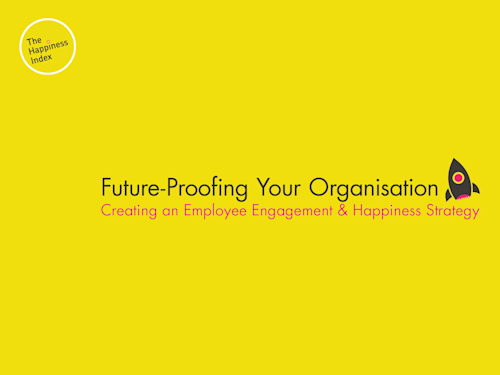
Creating an Employee Engagement AND Happiness Strategy
One of the topics we talk to organisations about time and time again is their response rates. Typically, they’ve run a survey in the past and found that not many people responded and they’ve felt that it hasn’t been worth their while. We can empathise! It’s demoralising to spend time and effort creating something only for there to be low uptake. Read on to understand what is a good survey response rate and how to improve it.
Think of it as a delicate engagement see-saw – you need to get the balance just right. By adopting the correct approach, you can create a programme that factors in the balance between the needs of your business and the needs of the respondent. This will ensure high response rates.
Here are some tips and tricks to help you boost response rates and engagement within your organisation…
Our benchmark for responses is 74% of employees. We think that this is a good benchmark to aim for and something most organisations can achieve. However, with the correct approach, we find that some of our customers can consistently get a response rate of over 80% for their employee engagement surveys.
Want to find out how? Read on…
One of the top reasons employees give for not participating is that they think it’s pointless. They may think it’s a tick box exercise, or that their feedback doesn’t matter and won’t be listened to. Or that nothing will be done with the feedback. Sometimes this is down to past ineffective listening strategies, but it may also be because of experiences in previous jobs or roles. Being proactive will start to build momentum within your organisation – if people see that you are genuinely actioning feedback, and creating positive change off the back of what their colleagues are saying, then they will be motivated to have their say too.
Another way you can help your people see that taking part in the survey isn’t a waste of time is by communicating a clear roadmap. We recommend explaining the longer-term strategy in the initial communications you create around your strategy. This should include information about when employee surveys are being launched, how long they will be open for and when people can expect to see the results. Once the results are shared with the wider organisation, you should also commit to an action roadmap. This may include workshops or team-based action planning to involve your people in the outcomes of your programme.
To create effective storytelling around your programme, thinking about how you tell your people about your programme is key. Good signposting and branding of your initiatives can have a big impact on response rates. Using consistent language and imagery around the programme will help your people recognise and remember your plan. We’re talking about marketing here really, but you also need to think about how and where you communicate. Ideally, you should put your communication where your people spend the most time. Depending on your team this might include internet or intranet, kiosks, posters or line manager communications.
One of the best ways of showing your people that their time won’t be wasted is by showing that there is buy-in from all levels of your organisation. Of course, putting your money where your mouth is and investing in a tool like The Happiness Index can show how serious your organisation is about making positive change. But we also recommend launching the programme with a key stakeholder for example the CEO or Chief People Officer. But you can go further. For example, you may create a working group with involvement from across the organisation. Or set up a larger meeting where senior team members discuss what they’re hoping to achieve through the activity.
It might seem obvious but the time you send out your engagement or happiness survey and communications can actually have a big impact on the success of your programme. If you launch Friday afternoon, the chances are you will have a poor initial response rate. You will see a similar picture with Monday morning launches. It’s not just what day of the week you’re looking at though. If you launch for 1-2 weeks during holiday periods you’re going to miss people. Thinking about when you’re sending surveys, how long they’re running for, and how and when you send out updates and reminders will be an important step in planning your programme.
If something comes out of the blue people are going to be less bothered about answering it. So when you’re creating your communication play you’ll need to think about how you show that the surveys are part of an overarching people strategy. For example, sending a wellbeing survey when you have communicated your wellbeing week or programme coming up, will make it more salient. Similarly, a future of work survey is more likely to get a good response rate if it’s framed in the context of a return to office plan or a wider review of remote working. And so on, you get the picture. Essentially, people don’t like answering random surveys that aren’t speaking directly to their needs and wants, so creating the story of that relevance is key. More on what employee surveys may be relevant for you here.
One of the most basic, but often overlooked areas of increasing response rate is to make it easy for people to do what you’re asking of them. Don’t make the survey too long, ensure it’s in your primary business language, and make sure it’s available to people on the device they’re most likely to be using, whether that’s mobile or desktop or something else. You also need to make sure you give people ample time to complete the survey. If you have workers who aren’t desk-based, for example, you might want to give them a specific 15-minute break. You might need to ensure they have ample WiFi, or a device for example a tablet in a dedicated space. We’ve found that some tea and biscuits don’t go amiss either.
Having a team of happiness and engagement advocates or champions can be helpful not only to spread the load of action planning, and to help show your team you mean business, but it can also help with response rate directly. These individuals can speak to their colleagues directly about the survey, advocate for its importance and encourage participation. From a neuroscience standpoint, this taps into social desirability bias – if we know other people are doing something then we want to do it too. Another great idea is to share response rate league tables. If you generate a bit of competition between teams or departments, you may find that when people see that others are having their say, they will want to get involved too.
If your first survey doesn’t get a great response rate, then it can be tempting to give up. Don’t worry though, sometimes customers find that as they build trust and transparency over time, response rates will pick up naturally. You might need to take some time to find the exact formula that works for your organisation. Keep at it and soon you’ll find you’re able to get plenty of people giving feedback to power your people strategy.
Check out our article on why to use pre-built employee surveys next.

Linked to Engagement in our neuroscience methodology... learn more
The Happiness Index helps organisations measure the key employee engagement AND happiness drivers to power their people strategy.
Our unique platform offers the products, insights and tools to shine a light on your cultural health and empower management to drive thriving cultures.
Our neuroscience-based pre-built surveys measure the full employee experience - from onboarding to exit to empower and enable organisations to understand their people and create data-led action plans.
